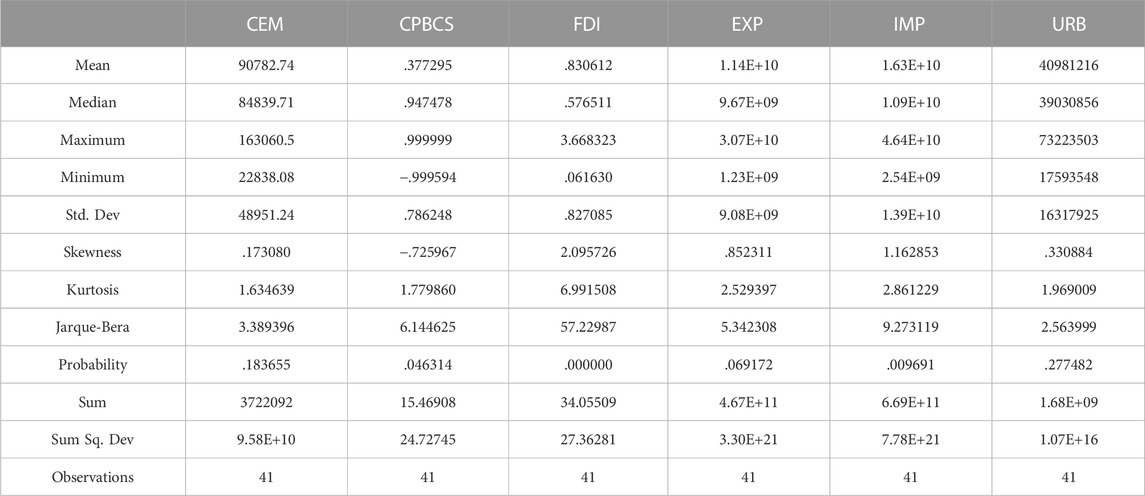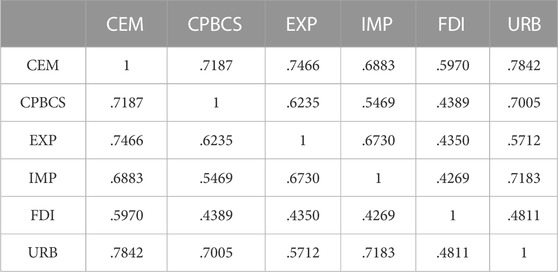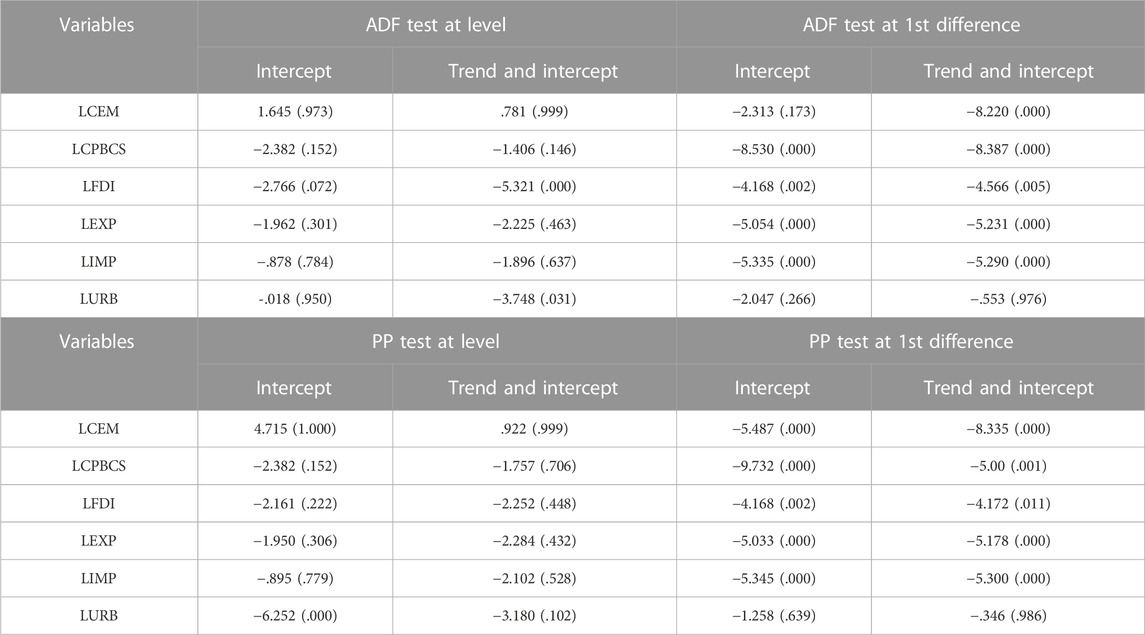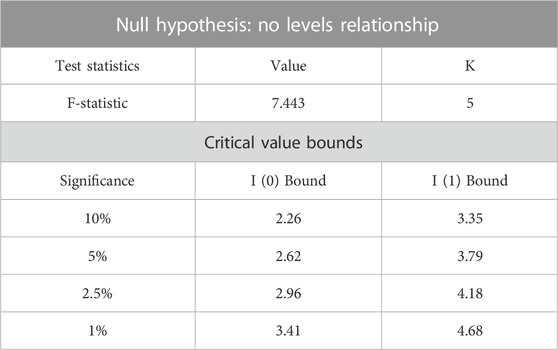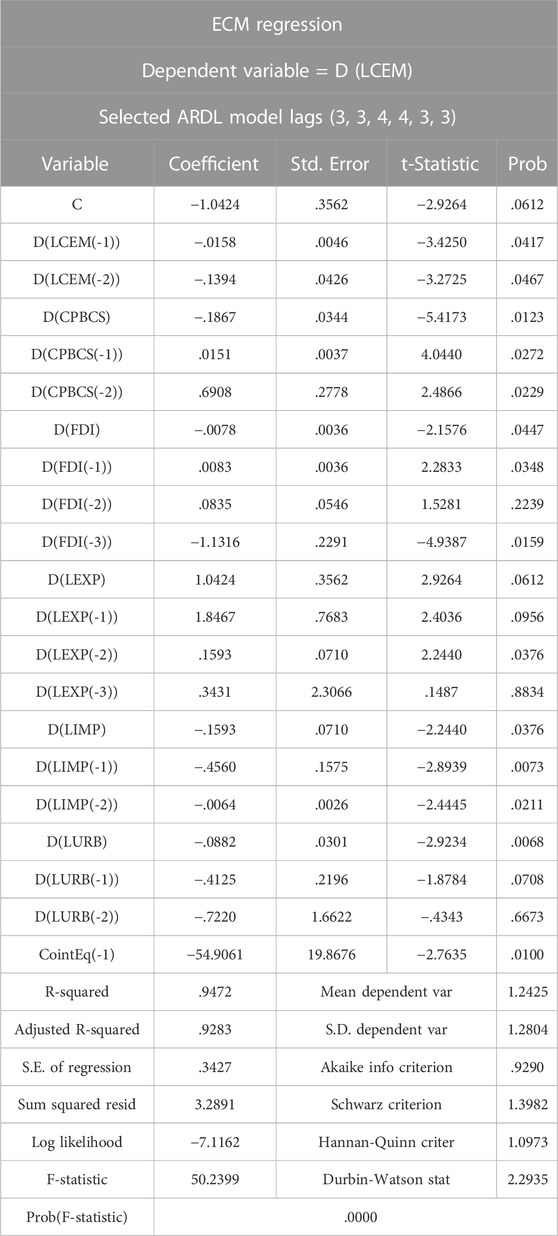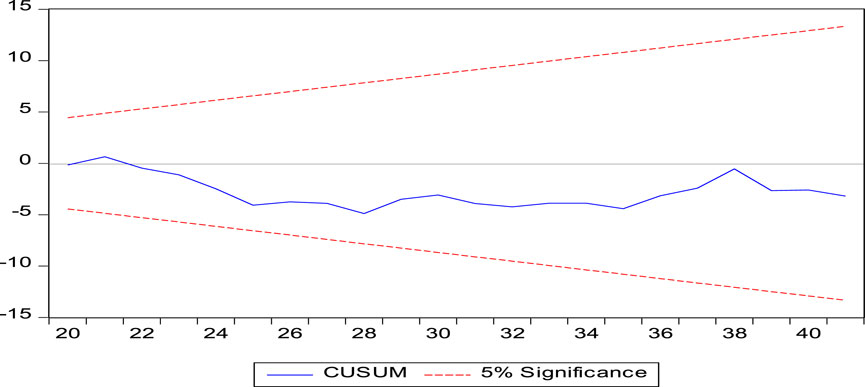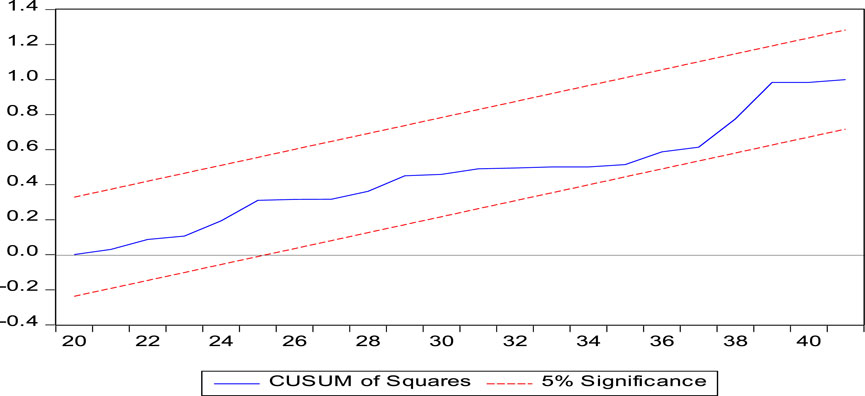- 1China Institute of Development Strategy and Planning, and Center for Industrial Economics, Wuhan University, Wuhan, China
- 2School of Economic and Management, and Center for Industrial Economics, Wuhan University, Wuhan, China
- 3Department of Economics, National College of Business Administration and Economics, Lahore, Pakistan
- 4Faculty of Economics, Thuongmai University, Hanoi, Vietnam
- 5School of Finance, Hubei University of Economics, Wuhan, China
- 6Department of Agricultural Economics and Rural Development, Seoul National University, Seoul, South Korea
This study investigates the empirical impact of China-Pak business cycle synchronization, urbanization, foreign direct investment, exports, and imports on environmental degradation in Pakistan from 1975 to 2017. In doing so, we use the Hodrick-Prescott filter to obtain the trend component of GDP. Then the trend component is subtracted from the original series of GDP to capture the cyclical component of China and Pakistan. The business cycle synchronization index is used to estimate synchronization between the business cycles of both countries. Using the ARDL method, we investigate the existence of a long-run co-integration relationship between the variables of interest. The empirical findings indicate that all explanatory variables (except FDI) are found to be significant factors of environmental degradation in the model. Furthermore, both imports and urbanization have a positive and significant impact on environmental degradation in Pakistan. At the same time, China-Pak business cycle synchronization and exports are discovered to have negative and significant coefficients for environmental degradation in Pakistan. The negative and significant ECM value indicates model convergence and a short-run relationship. The findings of the study suggest that improvement in China-Pak business cycle synchronization may be a factor that promotes environmental sustainability in Pakistan. An increase in exports and a decrease in imports can significantly contribute to reducing environmental degradation in Pakistan. A favorable balance of payment can provide sufficient financial prosperity to take environmental preservation measures. Policymakers should create effective urban planning, which has the potential to improve the country’s environmental quality.
1 Introduction
Rising temperatures and climate change make achieving sustainable development more difficult (Stern, 2009). Trade openness may facilitate the transfer of low-carbon technology from advanced economies to less developed economies and international investment in carbon-lowering measures, with climate change and environmental consequences (Ahmed et al., 2015). Since the 1990s, researchers have been focusing on the controversial phenomenon between environmental degradation and trade openness by investigating the bidirectional association between trade openness and ecological degradation. Grossman and Krueger (1991) presented a theoretical foundation for trade openness and environmental nexus on three bases: scale effect, composition effect and technique effect. The composition effect is related to comparative advantage production structure. Carbon emissions increase as the demand for dirty goods rises. The scale effect is a positive association between trade openness and the environment based on higher energy consumption and production level. When revenues are low, the scale effect is stronger, and when revenues are high the effect is weaker. The technique effect considers trade openness as beneficial to income level, which improves technical know-how, and cleaner production processes take place, reducing environmental degradation.
Literature has highlighted the influence of foreign trade and economic association among countries on environmental degradation (Kahouli and Omri, 2017; Shao et al., 2021). Environmental degradation hurts trade openness, as explained by Copeland and Taylor (2004) in the famous “pollution haven effect.” Pollution regulations are viewed as trade hindering because regulations to control carbon emissions have an impact on plant location decisions, level of openness, and trade flows. According to Jaffe et al. (1995) restrictive environmental procedures resulted little (or no) impact on investment flows and volume of trade openness.
In addition, studies find that foreign direct investment has a significant impact on carbon emissions. A well-known phenomenon has been that developed economies seek to locate their industrial units in less developed economies where sufficient natural resources and a cheaper labor force are available. As a result, increasing foreign direct investment can endanger environmental quality in developing countries, which is known as the pollution haven hypothesis and has been confirmed in the case of many countries in the recent literature (Chung, 2014; Wang and Chen, 2014; Azam et al., 2015; Neequaye and Oladi, 2015; Zhang and Zhou, 2016; Farooq et al., 2021). Researchers also concluded that countries with stringent environmental policies were less attractive to foreign direct investment (Halicioglu and Ketenci, 2016; Rafiq et al., 2016; Adewuyi and Awodumi, 2017).
Pakistan’s trade share with China has been increasing particularly Pakistani imports from China. China is the top trading partner of Pakistan, accounting for 29 percent of total imports from China. China’s inclusion in the model matters because, according to International Energy Agency (2017), China alone produces 9,040.7 Mt of carbon emissions, accounting for 28 percent of global carbon emissions. The present study makes an important contribution to the existing body of literature by analyzing the potential impact of China-Pak business cycle synchronization, as well as global trade on environmental degradation in Pakistan. Given the link between FDI and carbon emissions that has been established in the literature, this study identifies FDI as a cause of environmental degradation in Pakistan. While researchers continued to focus on the link between urbanization and environmental degradation, they discovered that rapid urbanization was one of the factors causing environmental problems through air pollution (Solarin and Lean, 2016; Bello et al., 2018). To this end, this study further aims to analyze the potential influence of urbanization and FDI on environmental degradation in Pakistan.
The paper is organized as follows. Section 2 reviews the literature while Section 3 contains Data Specifications and Methodology. The Results and Discussion are outlined in Section 4. Section 5 concludes the study and its policy implications.
2 Literature review
Attaining sustainable development is a global objective in the current era of development. A significant amount of studies that have investigated the impact of different macroeconomic indicators on CO2 Emissions (CEM) for achieving sustainable development, including Cai et al. (2021); Liu H. et al. (2022); Anwar and Malik (2021); Anwar et al. (2022c); Salem et al. (2021); Wang et al. (2022); Sun et al. (2022); Anwar et al. (2021b); Wen et al. (2022); Siddique et al. (2020); Pao and Tsai (2011) examined the impact of financial development and economic growth on environmental degradation in Russia from 1992 to 2007, as well as in China, Brazil, and India from 1980 to 2007. Results revealed a significant association between energy consumption and carbon emissions. While an inelastic relationship between FDI and carbon emissions was discovered. The pollution haven hypothesis was found true in all economies with scale effects and halo effects; Hitam and Borhan (2012) used a non-linear model to examine association between FDI inflows and environmental quality in Malaysia from 1965 to 2010. Their findings revealed that FDI has a positive impact on environmental degradation and confirmed the environmental Kuznets curve in Malaysia. Carbon emissions were also positively associated with GDP per capita, imports, and population density. In contrast, carbon emissions were negatively correlated with exports and GDP per capita. Omri et al. (2014) used data from 1990 to 2011 to investigate the nexus between foreign direct investment, economic growth, and carbon emissions in 54 economies using data from 1990 to 2011. Results showed bidirectional causality among all panels between carbon emissions and FDI except North Asia and Europe. Input-output analysis was used by Ren et al. (2014) to measure carbon emissions in the case of China for the period 2000 to 2010. A positive and significant association between trade openness and carbon emissions was found. Results further revealed that FDI had an impact on CO2 emissions and that environmental Kuznets curve was present in the case of the industrial sector of China. In a panel of ASEAN economies, Baek (2016) discovered that FDI had a direct and significant relationship with carbon emissions, confirming the plausibility of the pollution haven hypothesis. Doytch and Uctum (2016) examined the halo effect of FDI on environmental quality from 1984 to 2011 by dividing the global economy into low-income, middle-income, and advanced countries into low-income, middle-income, and advanced countries. The negative halo effect was found when net FDI inflows into the industrial sector increased the carbon emissions, which was referred to as the differential industry effect. Taking income inequality into account, the results revealed that FDI inflows have a positive impact on pollution in low-income and middle-income economies. At the same time, it found advanced countries with a favorable environment regulations improved the impact of FDI inflows. Taghavee et al. (2016) used annual time series data from 1974 to 2012 to analyze the relationship between environment quality, GDP, energy consumption, and financial development in the case of Iran. The study’s results depicted significant interaction among per capita carbon emissions, GDP, and energy consumption over the long term, while during short-term financial development, it found labor force and trade openness were significant factors. Abdouli and Hammami (2017) examined the causality linkages between economic growth, FDI, and environmental degradation in 17 MENA economies. The results showed a one-sided causality link between FDI and carbon emissions to economic growth, while global causality analysis revealed bidirectional causality between carbon emissions and FDI, and between economic growth and carbon emissions. Empirical findings revealed a neutral association between the quality of the environment and economic growth. Bakhsh et al. (2017) examined the effects of FDI on GDP and carbon emissions in Pakistan from 1980 to 2014. Labor and capital stock were found to have a significant positive influence on economic growth. There was a negative relationship between economic growth and carbon emissions. The study also found that GDP positively influenced carbon emissions, but when pollution exceeded a certain threshold, GDP declined. Solarin et al. (2017) analyzed the contribution of FDI and institutional quality on carbon emissions in the case of Ghana for the period 1980–2012, and found a positive impact of energy consumption, trade openness, and FDI inflows on environmental degradation. At the same time, better institutional quality was found as an environment-improving factor. Sun et al. (2017) found evidence of the pollution haven hypothesis in China, where FDI had a negative impact on carbon emissions. In the case of the Gulf Cooperation Council (GCC), Rafindadi et al. (2018) discovered that FDI had an inverse and statistically significant relationship with carbon emissions, while energy use increased carbon emissions. To reduce carbon emissions, the study recommended favorable energy mix management and increased FDI inflows. Bello et al. (2018) analyzed the impact of hydroelectricity consumption on environmental degradation in Malaysia from 1971 to 2016, and confirmed the presence of the environmental Kuznets curve. The findings further revealed that urbanization and hydroelectricity use were important drivers of emissions-increasing factor, but in the case of air pollution, urbanization was found responsible in Malaysia. Anoulies (2016) conducted a quantitative analysis of OECD countries from 1990 to 2011, arguing that greater trade integration led to increased global competition. In the fact of global market competition, considering safe environmental policy has become critical for economies worldwide. The study concluded that increased international trade leads to increased international transport movement and higher emissions. Le et al. (2016) considered trade openness to analyze the environmental Kuznets curve in 98 countries from 1990 to 2013. A global panel of all included found 98 countries with a negative impact of trade openness on the quality of the environment. Trade environment-friendly relationship was found in high-income countries, while the trade openness had a negative impact on environmental quality in middle and low-income countries. The results refuted the EKC hypothesis in a global panel of countries. In contrast, Shahbaz et al. (2017) investigated the impact of trade openness and economic growth on environmental degradation in 105 low, middle and high-income countries from 1980 to 2014. The study concluded that trade openness has a significant impact on environmental degradation in the global panel and panels of three income groups of countries. The results confirmed the presence of EKC in all four panels of the study. The study suggested technology inflows from developed countries to developing countries for the improved environment in developing countries. Mutascu (2018) examined the simultaneous movement of carbon emissions and trade openness in France from 1960 to 2013. The results supported the neutral hypothesis that the absence of high-frequency co-movement between carbon emissions and trade openness in the short term indicated a medium-term positive association between both variables. A strong environmental protection policy was found to be supportive of increased cross-borders trade. The business cycle played an important role in the long-term nexus between trade and carbon emissions.
Ding et al. (2018) analyzed the global environmental impact of China’s bilateral trade with 219 countries from 2000 to 2014. From an environmental standpoint, the study estimated export and import separately. During the entire study period, Chinese exports to the countries had a greater positive impact on environmental degradation than Chinese imports. However, the net charge of bilateral trade on global carbon emissions was found smaller since 2011. Based on the results, bilateral trade is not becoming more environmentally unfriendly over time. Crowley and Hallett (2018) investigated the transfer mechanism of volatility from high-frequency business cycles to low-frequency business cycles in the United States using classical monetary models and the New Keynesian model. According to the results, decreased inflation and output stability aided the transition from shorter to longer cycles. The study found that the severe recession phase was caused by the long-term smooth expansion phase of economic stability. Sahoo and Sahoo (2022) explored the impact of renewable and non-renewable energy on environmental degradation in India from 1965 to 2018. They came to the conclusion that hydro energy consumption has a positive impact on CO2 emissions. The unfavorable impact of electricity consumption and financial development on environmental sustainability was found in India. At the same time, ICT played a positive role in environmental quality (Sahoo et al., 2021). Urbanization benefited environmental in India through energy efficiency and better infrastructure (Villanthenkodath et al., 2021). Gupta et al. (2022) found that urbanization and economic growth had a lower impact on Bangladesh’s ecological. Natural resources and technological innovation also contributed to the improvement of environmental quality. EKC was also discovered in Bangladesh between 1990 and 2016. Rout et al. (2022) conducted research for BRICS countries and confirmed the presence of EKC. The long-term impact of non-renewable energy consumption and technological diffusion was detrimental to environmental quality. Ali et al. (2022) investigated the factors of environmental degradation in Pakistan from 1971 to 2018. They found that economic expansion and increased agricultural output improved environmental sustainability in Pakistan. At the same time, the role of conventional energy was detrimental to environmental quality. Using the ASEAN countries’ data, Anwar et al. (2021) documented that urbanization raised the CEM. Similarly, Anwar et al. (2021a) found that urbanization was a major contributor to CEM in China. Chien et al. (2021), Jun et al. (2021), Habiba et al. (2022), and Anwar et al. (2022) investigated that FDI was positively linked with CEM. Anwar et al. (2022b) explored that trade was a significant determinant of CEM in emerging economies.
3 Data specifications and methodology
China-Pak business cycle synchronization and environmental degradation nexus are analyzed in this study. Other explanatory variables include, net foreign direct investment inflows, exports, imports and urbanization. Data for the whole series are taken from world development indicators published by World Bank (2019) from 1975 to 2017. Descriptive statistics of all variables with original data values were given in Table 1 and correlation between all variables is given in Table 2.
Carbon emissions (CEM) is used as the dependent variable to represent environmental degradation in Pakistan. The unit of carbon emission is kiloton (kt). Business cycles of China and Pakistan are measured through the log of de-trended GDP through the Hodrick Prescott (HP) filter. HP filter calculates the trend component of GDP, subtracted from the original GDP series to obtain a cyclical component of GDP that is considered a country’s business cycle. China and Pakistan business cycle synchronization (CPBCS) is estimated through the business cycle synchronization index developed by Frankel and Rose (1998) and Akın (2012), which is given as follows in Eq. 2.
In Eq. 2.
To maintain normality and uniform presentation of the series, variables are converted into a log form. The econometric form of the model is given as follows (Eq. 3).
where,
The error correction version of ARDL is given in Eq. 4.
In Eq. 4, “∆” is operator of first difference. In the above equation bi, ci, di, ei, fi and gi show the dynamics in the short run. While δ1, δ2, δ3, δ4, δ5 and δ6 represent long term coefficients. The white noise error term is shown by εt. Null hypothesis is that δ1 = δ2 = δ3 = δ4 = δ5 = δ6 = 0 which indicates that long run relationship does not exists. Alternative hypothesis is that δ1 ≠ δ2 ≠ δ3 ≠ δ4 ≠ ≠ δ5 ≠ δ6 ≠ 0 which indicates that long term relationship exists.
Long-run coefficients of the model have been estimated as given in Eq. 5.
Following Eq. 6 is used for ECM to estimate short-run coefficients.
To investigate the empirical impact of business cycle synchronization and other macroeconomic variables on environmental degradation in Pakistan, the present study utilizes the ARDL econometric approach, which is more appropriate when variables are stationary with a mix of level I (0) and the first difference I (1). Compared with Johansen and Juselius’s cointegration methodology, the ARDL approach is better for estimating short-run and long-run relationships (Haug, 2002). Furthermore, the ARDL model is helpful for small data duration and extensive periods. The ARDL approach can perform dynamic relationship analysis through a single equation framework. Lagged values of independent variables are included in the ARDL model, which captures the role of an independent variable’s past value on the dependent variable’s current value.
4 Results and discussion
The study uses unit root tests to confirm stationarity in the series. The F-bounds test is employed to check the presence of co-integration among the dependent and independent variables. The ARDL method and ECM regression are used to capture short-term and long-term relationship coefficients. Granger causality and stability tests are used for causality linkages and stability of the model, respectively. The results of all the methods mentioned above are given below and discussed later.
4.1 Unit root tests
Phillips Perron (PP) and Augmented Dickey-Fuller (ADF) unit root tests are used to check the stationarity among all variables. The results are presented in Table 3 as previous unit root tests shows the same results regarding all the variables except FDI. The dependent variable LECM is found stationary at first with a 1 percent significance level. Independent variables are found motionless with a mix of class and first difference. CPBCS, LEXP, LIMP, and LURB are stationarity at the first difference, and the ADF test shows that FDI is stationarity at the level.
Results of unit root tests confirm the utilization of the ARDL regression model as the dependent variable is stationary at the first difference, and overall variables show a mixture of stationarity at the level and first difference.
4.2 F-bounds test
The F-bounds test is utilized to confirm co-integration in the model, and the results were presented in Table 4. The value of the F-Statistic is 7.443, which shows significance at a 1 per cent level of effectiveness as this is higher than critical values of the lower bound and upper bound, which are 3.41 and 4.68, respectively. The null hypothesis of no association is rejected based on the value of the F-Statistic.
The F-Bounds test shows the presence of co-integration in the model by accepting the alternative hypothesis. This outcome allows for further regression analysis of the model to analyze the short-term and long-term relationship among variables.
4.3 ARDL model
Long-run estimates of the model are presented in Table 5, where carbon emissions is the dependent variable.
Long-run estimates of the present study are significant as the influence of the economic association of China and Pakistan has been examined through the ARDL approach. As compared with past literature, the present study not only estimates the role of total exports and imports for environmental quality in Pakistan but the impact of China-Pak business cycle synchronization is also empirically analyzed. Empirical findings of the study show the China-Pak business cycle synchronization’s negative and significant impact on carbon emissions in Pakistan. This outcome indicates that an increase in the co-movement of business cycles between China and Pakistan leads to reduced environmental degradation in Pakistan. As China has become a rapidly growing economy, Pakistan is making more economic integration with China. China-Pak Economic Corridor (CPEC) and bilateral trade have increased during the last few decades. More business cycle synchronization of Pakistan with China indicates that Pakistan’s economy also steps forward to a booming economy in the presence of more economic integration with China. With such rapid economic growth, an economy can take adequate measures to reduce environmental degradation. The results are consistent with Shahbaz et al. (2017), where the same direction of the relationship was present for trade and environmental quality. Higher synchronization represents a good sign for a country when another economy is recovering (Paul, 2010).
The results of our study depicts China-Pak business cycle synchronization as an essential factor in reducing environmental degradation in Pakistan. The positive association between FDI and carbon emission matches what shown by Solarin et al. (2017). Exports are found environment friendly in Pakistan as results shows that a 1 per cent increase in exports brought a .88 percent decrease in carbon emissions. This outcome is consistent with Hitam and Borhan (2012). Exports uplift foreign reserves and can be utilized to launch environmental protection policy measures. They found a positive and significant linkage between imports and carbon emissions. It can be concluded as due to higher senses, foreign payments increase which leads to financial resource deficiency for the country itself and initiating measures for environmental protection becomes difficult. This relationship was consistent with Williams and Kerr (2016). Economic development positively impacted ecological degradation in Pakistan and matched with what shown by Sun et al. (2017). The results show a direct and significant impact of urbanization on environmental degradation in Pakistan.
4.4 Error correction model
Short-run regression results are presented in Table 6. China-Pak business cycle synchronization has a significant association with positive coefficients of lag values which indicates that in the short run, business cycle synchronization between China and Pakistan could cause an increase in carbon emissions in Pakistan. FDI shows a significant positive impact on carbon emissions in Pakistan, which reveals that in the short run, FDI is not environment-friendly for Pakistan. Imports and urbanization negatively influenced carbon emissions. The magnitude of the error correction term is found to be negative and effective at a 1 percent level of significance which shows the presence of short-run equilibrium in the model. The value of R-square is .9427, which explains that 85 percent of variations in the dependent variable are estimated through included explanatory variables in the model. F-statistics is also significant at a 1 percent level of significance. Durbin-Watson’s value is 2.29, sufficient to confirm that there is no autocorrelation in the model as the value of D. W stat is higher than 1.96.
4.5 VAR granger causality
The order of integration of variables of the present study is a mix of level and first difference, which supports the VAR Granger Causality test developed by Toda and Yamamoto (1995). The Granger Causality test results are presented in Table 7, where causality is present with a mix of unidirectional, bidirectional, and no reason. Carbon emission (CEM) is caused by FDI, export, and urbanization, while as the independent variable, CEM Granger causes exports and imports. No causality linkage of CEM is found with China-Pak business cycle synchronization and foreign direct investment. China-Pak business cycle synchronization is Granger driven by exports and urbanization. Urbanization, FDI, and CEM Granger cause to export while import is Granger caused by CEM, FDI, export, and urbanization. All variables of the model except CEM Granger cause urbanization.
4.6 Stability tests
Figures 1, 2 are presented to show the outcomes of the CUSUM and CUSUM-square tests. Brown et al. (1975) stated that such a presentation confirms the stability of the model in the short term and long term. The Results show that estimated CUSUM and CUSUM-square are within the boundary limits of a 5 percent level of significance which verifies the stability of the model.
5 Conclusion and policy recommendations
This study empirically assesses the impact of China-Pak business cycle synchronization on environmental degradation in Pakistan. The study considers a variety of factors with environmental affects including foreign direct investment, exports, imports, and urbanization. Unit roots (ADF and PP) show that variables are stationary with a mix of level and first difference. The F-bounds test confirms the existence of co-integration in the model. The ARDL methodology is employed for long-run estimates of the model. All explanatory variables, with the exception of foreign direct investment, are significantly associated with carbon emissions. China-Pak business cycle synchronization and total exports have an inverse impact on carbon emissions, while other independent variables with positive coefficients for Pakistan carbon emissions are discovered. Granger causality analysis reveals unidirectional linkages among the variables except only one bidirectional causality linkage which is China-Pak business cycle synchronization and urbanization. CUSUM and CUSUM square stability tests assure the stability of the model.
The economy of Pakistan requires more economic resources to develop effective carbon-cutting measures which can be accomplished by improving business cycle synchronization between China and Pakistan. Based on the empirical findings of the present study, an increase in China-Pak business cycle synchronization can help improve Pakistan’s environmental quality. China has become a rapidly growing economy in recent decades, and Pakistan’s economy can move to recovery and finally boom phase in its business cycle by improving economic linkages and business cycle synchronization with China. Results show exports as a supportive factor for environmental quality so, exports encouraging measures should be promoted as earnings from exports can be utilized for environmental protection initiatives, while reliance on imports should decrease to improve ecological quality in Pakistan. Urbanization is the movement of people from rural to urban areas, which ultimately puts pressure on the natural environment through air pollution (Uttara et al., 2012). This study also suggested that urbanization issue be considered in the context of Pakistan’s environmental degradation.
This study has some limitations as we only utilize the data of China to measure the impact of CPBCS on the environmental degradation of Pakistan. Therefore, future studies can also explore the impact of BCS on the environment by employing the data of other trading partners of Pakistan.
Data availability statement
The original contributions presented in the study are included in the article/supplementary material, further inquiries can be directed to the corresponding author.
Author contributions
All authors listed have made a substantial, direct, and intellectual contribution to the work and approved it for publication.
Funding
This work is supported by the National Social Science Foundation Project of China (No. 21BJL008).
Conflict of interest
The authors declare that the research was conducted in the absence of any commercial or financial relationships that could be construed as a potential conflict of interest.
Publisher’s note
All claims expressed in this article are solely those of the authors and do not necessarily represent those of their affiliated organizations, or those of the publisher, the editors and the reviewers. Any product that may be evaluated in this article, or claim that may be made by its manufacturer, is not guaranteed or endorsed by the publisher.
Abbreviations
CPBCS, China-Pak Business Cycle Synchronization; CEM, CO2 Emissions; FDI, Foreign Direct Investment; EXP, Exports; IMP, Imports; URB, Urbanization; ECM, Error Correction Model; BCS, Business Cycle Synchronization.
References
Abdouli, M., and Hammami, S. (2017). Investigating the causality links between environmental quality, foreign direct investment and economic growth in MENA countries. Int. Bus. Rev. 26 (2), 264–278. doi:10.1016/j.ibusrev.2016.07.004
Adewuyi, A. O., and Awodumi, O. B. (2017). Biomass energy consumption, economic growth and carbon emissions: Fresh evidence from West Africa using a simultaneous equation model. Energy 119, 453–471. doi:10.1016/j.energy.2016.12.059
Ahmed, K., Shahbaz, M., Qasim, A., and Long, W. (2015). The linkages between deforestation, energy and growth for environmental degradation in Pakistan. Ecol. Indic. 49, 95–103. doi:10.1016/j.ecolind.2014.09.040
Akın, Ç. (2012). Multiple determinants of business cycle synchronization. Washington, DC, USA: Department of Economics, George Washington University. Unpublished manuscript.
Ali, H. S., Sahoo, M., Alam, M., Tijjani, I. I. I., Al-Amin, A. Q., and Ahmed, A. (2022). Structural transformations and conventional energy-based power utilization on carbon emissions: Empirical evidence from Pakistan, Environ. Dev. Sustain. 1–24.
Anoulies, L. (2016). Are trade integration and the environment in conflict? The decisive role of countries’ strategic interactions. Int. Econ. 148, 1–15. doi:10.1016/j.inteco.2016.06.001
Anwar, A., Chaudhary, A. R., and Malik, S. (2022c). Modeling the macroeconomic determinants of environmental degradation in E-7 countries: The role of technological innovation and institutional quality. J. Public Aff., e2834. doi:10.1002/pa.2834
Anwar, A., Malik, S., and Ahmad, P. (2022b). Cogitating the role of technological innovation and institutional quality in formulating the sustainable development goal policies for E7 countries: Evidence from quantile regression. Glob. Bus. Rev., 097215092110726. doi:10.1177/09721509211072657
Anwar, A., and Malik, S. (2021). Cogitating the role of technological innovation and institutional quality on environmental degradation in G-7 countries. Int. J. Green Econ. 15 (3), 1–232. doi:10.1504/ijge.2021.10044262
Anwar, A., Sharif, A., Fatima, S., Ahmad, P., Sinha, A., Khan, S. A. R., et al. (2021a). The asymmetric effect of public private partnership investment on transport CO2 emission in China: Evidence from quantile ARDL approach. J. Clean. Prod. 288, 125282. doi:10.1016/j.jclepro.2020.125282
Anwar, A., Siddique, M., Dogan, E., and Sharif, A. (2021b). The moderating role of renewable and non-renewable energy in environment-income nexus for ASEAN countries: Evidence from Method of Moments Quantile Regression. Renew. Energy 164, 956–967. doi:10.1016/j.renene.2020.09.128
Anwar, A., Sinha, A., Sharif, A., Siddique, M., Irshad, S., Anwar, W., et al. (2022). The nexus between urbanization, renewable energy consumption, financial development, and CO2 emissions: Evidence from selected asian countries. Environ. Dev. Sustain. 24 (5), 6556–6576. doi:10.1007/s10668-021-01716-2
Azam, M., Khan, A. Q., Zaman, K., and Ahmad, M. (2015). Factors determining energy consumption: Evidence from Indonesia, Malaysia and Thailand. Renew. Sustain. Energy Rev. 42, 1123–1131. doi:10.1016/j.rser.2014.10.061
Bakhsh, K., Rose, S., Ali, M. F., Ahmad, N., and Shahbaz, M. (2017). Economic growth, CO2 emissions, renewable waste and FDI relation in Pakistan: New evidences from 3SLS. J. Environ. Manag. 196, 627–632. doi:10.1016/j.jenvman.2017.03.029
Bello, M. O., Solarin, S. A., and Yen, Y. Y. (2018). The impact of electricity consumption on CO 2 emission, carbon footprint, water footprint and ecological footprint: The role of hydropower in an emerging economy. J. Environ. Manag. 219, 218–230. doi:10.1016/j.jenvman.2018.04.101
Brown, R. L., Durbin, J., and Evans, J. M. (1975). Techniques for testing the constancy of regression relationships over time. J. R. Stat. Soc. Ser. B Methodol. 37 (2), 149–163. doi:10.1111/j.2517-6161.1975.tb01532.x
Cai, Y., Xu, J., Ahmad, P., and Anwar, A. (2021). What drives carbon emissions in the long-run? The role of renewable energy and agriculture in achieving the sustainable development goals. Econ. Research-Ekonomska Istraživanja, 1–22. doi:10.1080/1331677X.2021.2015613
Chien, F., Anwar, A., Hsu, C. C., Sharif, A., Razzaq, A., and Sinha, A. (2021). The role of information and communication technology in encountering environmental degradation: Proposing an SDG framework for the BRICS countries. Technol. Soc. 65, 101587. doi:10.1016/j.techsoc.2021.101587
Chung, S. (2014). Environmental regulation and foreign direct investment: Evidence from South Korea. J. Dev. Econ. 108, 222–236. doi:10.1016/j.jdeveco.2014.01.003
Copeland, B. R., and Taylor, M. S. (2004). Trade, growth, and the environment. J. Econ. literature 42 (1), 7–71. doi:10.1257/.42.1.7
Crowley, P. M., and Hallett, A. H. (2018). What causes business cycles to elongate, or recessions to intensify? J. Macroecon. 57, 338–349. doi:10.1016/j.jmacro.2018.06.010
Ding, T., Ning, Y., and Zhang, Y. (2018). The contribution of China’s bilateral trade to global carbon emissions in the context of globalization. Struct. Change Econ. Dyn. 46, 78–88. doi:10.1016/j.strueco.2018.04.004
Doytch, N., and Uctum, M. (2016). Globalization and the environmental impact of sectoral FDI. Econ. Syst. 40 (4), 582–594. doi:10.1016/j.ecosys.2016.02.005
Farooq, A., Anwar, A., Ahad, M., Shabbir, G., and Imran, Z. A. (2021). A validity of environmental Kuznets curve under the role of urbanization, financial development index and foreign direct investment in Pakistan. J. Econ. Adm. Sci. doi:10.1108/JEAS-10-2021-0219
Frankel, J. A., and Rose, A. K. (1998). The endogenity of the optimum currency area criteria. Econ. J. 108 (449), 1009–1025. doi:10.1111/1468-0297.00327
Grossman, G. M., and Krueger, A. B. (1991). Environmental impacts of a North American free trade agreement (No. w3914). (United States: Cambridge, Massachusetts). National Bureau of Economic Research.
Gupta, M., Saini, S., and Sahoo, M. (2022). Determinants of ecological footprint and PM2. 5: Role of urbanization, natural resources and technological innovation. Environ. Challenges 7, 100467. doi:10.1016/j.envc.2022.100467
Habiba, U. M. M. E., Xinbang, C., and Anwar, A. (2022). Do green technology innovations, financial development, and renewable energy use help to curb carbon emissions? Renew. Energy 193, 1082–1093. doi:10.1016/j.renene.2022.05.084
Halicioglu, F., and Ketenci, N. (2016). The impact of international trade on environmental quality: The case of transition countries. Energy 109, 1130–1138. doi:10.1016/j.energy.2016.05.013
Haug, A. A. (2002). Temporal aggregation and the power of cointegration tests: A Monte Carlo study. Available at SSRN 334965.
Hitam, M. B., and Borhan, H. B. (2012). FDI, growth and the environment: Impact on quality of life in Malaysia. Procedia-Social Behav. Sci. 50, 333–342. doi:10.1016/j.sbspro.2012.08.038
International Energy Agency (IEA) (2017). CO2 emissions from fuel combustion highlights. Available at: https://www.iea.org/publications/freepublications/publication/CO2EmissionsfromFuelCombustionHighlights2017.pdf.
Jaffe, A. B., Peterson, S. R., Portney, P. R., and Stavins, R. N. (1995). Environmental regulation and the competitiveness of US manufacturing: What does the evidence tell us? J. Econ. literature 33 (1), 132–163.
Kahouli, B., and Omri, A. (2017). Foreign direct investment, foreign trade and environment: New evidence from simultaneous-equation system of gravity models. Res. Int. Bus. Finance 42, 353–364. doi:10.1016/j.ribaf.2017.07.161
Le, T. H., Chang, Y., and Park, D. (2016). Trade openness and environmental quality: International evidence. Energy policy 92, 45–55. doi:10.1016/j.enpol.2016.01.030
Liu, H., Anwar, A., Razzaq, A., and Yang, L. (2022). The key role of renewable energy consumption, technological innovation and institutional quality in formulating the SDG policies for emerging economies: Evidence from quantile regression. Energy Rep. 8, 11810–11824. doi:10.1016/j.egyr.2022.08.231
Liu, L., Anwar, A., Irmak, E., and Pelit, I. (2022). Asymmetric linkages between public-private partnership, environmental innovation, and transport emissions. Econ. Research-Ekonomska Istraživanja, 1–22. doi:10.1080/1331677X.2022.2049979
Majeed, M. T., and Mazhar, M. (2019). Financial development and ecological footprint: A global panel data analysis. Pak. J. Commer. Soc. Sci. (PJCSS) 13 (2), 487–514.
Mesagan, E. P. (2021). Environmental sustainability in sub-saharan africa: The case of production and consumption activities. J. Knowl. Econ. 13, 2840–2867. doi:10.1007/s13132-021-00842-6
Muhammad, B., and Khan, M. K. (2021). Foreign direct investment inflow, economic growth, energy consumption, globalization, and carbon dioxide emission around the world. Environ. Sci. Pollut. Res. 28 (39), 55643–55654. doi:10.1007/s11356-021-14857-8
Mutascu, M. (2018). A time-frequency analysis of trade openness and CO2 emissions in France. Energy policy 115, 443–455. doi:10.1016/j.enpol.2018.01.034
Neequaye, N. A., and Oladi, R. (2015). Environment, growth, and FDI revisited. Int. Rev. Econ. Finance 39, 47–56. doi:10.1016/j.iref.2015.06.002
Omri, A., Nguyen, D. K., and Rault, C. (2014). Causal interactions between CO2 emissions, FDI, and economic growth: Evidence from dynamic simultaneous-equation models. Econ. Model. 42, 382–389. doi:10.1016/j.econmod.2014.07.026
Pao, H. T., and Tsai, C. M. (2011). Multivariate granger causality between CO2 emissions, energy consumption, FDI (foreign direct investment) and GDP (gross domestic product): Evidence from a panel of BRIC (Brazil, Russian federation, India, and China) countries. Energy 36 (1), 685–693. doi:10.1016/j.energy.2010.09.041
Paul, B. P. (2010). Liberalization and India's business cycle synchronization with the US. Indian Econ. Rev., 159–182.
Petrović, N., Bojović, N., and Petrović, J. (2016). Appraisal of urbanization and traffic on environmental quality. J. CO2 Util. 16, 428–430. doi:10.1016/j.jcou.2016.10.010
Rafindadi, A. A., Muye, I. M., and Kaita, R. A. (2018). The effects of FDI and energy consumption on environmental pollution in predominantly resource-based economies of the GCC. Sustain. Energy Technol. Assessments 25, 126–137. doi:10.1016/j.seta.2017.12.008
Rafiq, S., Salim, R., and Nielsen, I. (2016). Urbanization, openness, emissions, and energy intensity: A study of increasingly urbanized emerging economies. Energy Econ. 56, 20–28. doi:10.1016/j.eneco.2016.02.007
Ren, S., Yuan, B., Ma, X., and Chen, X. (2014). International trade, FDI (foreign direct investment) and embodied CO2 emissions: A case study of chinas industrial sectors. China Econ. Rev. 28, 123–134. doi:10.1016/j.chieco.2014.01.003
Rout, S. K., Gupta, M., and Sahoo, M. (2022). The role of technological innovation and diffusion, energy consumption and financial development in affecting ecological footprint in BRICS: An empirical analysis. Environ. Sci. Pollut. Res. 29 (17), 25318–25335. doi:10.1007/s11356-021-17734-6
Sahoo, M., Gupta, M., and Srivastava, P. (2021). Does information and communication technology and financial development lead to environmental sustainability in India? An empirical insight. Telematics Inf. 60, 101598. doi:10.1016/j.tele.2021.101598
Sahoo, M., and Sahoo, J. (2022). Effects of renewable and non-renewable energy consumption on CO 2 emissions in India: Empirical evidence from disaggregated data analysis. J. Public Aff. 22 (1), e2307. doi:10.1002/pa.2307
Salem, S., Arshed, N., Anwar, A., Iqbal, M., and Sattar, N. (2021). Renewable energy consumption and carbon emissions—Testing nonlinearity for highly carbon emitting countries. Sustainability 13 (21), 11930. doi:10.3390/su132111930
Shahbaz, M., Nasreen, S., Ahmed, K., and Hammoudeh, S. (2017). Trade openness–carbon emissions nexus: The importance of turning points of trade openness for country panels. Energy Econ. 61, 221–232. doi:10.1016/j.eneco.2016.11.008
Shao, J., Tillaguango, B., Alvarado, R., Ochoa-Moreno, S., and Alvarado-Espejo, J. (2021). Environmental impact of the shadow economy, globalisation, trade and market size: Evidence using linear and non-linear methods. Sustainability 13 (12), 6539. doi:10.3390/su13126539
Siddique, M., Anwar, A., and Quddus, M. A. (2020). The impact of real effective exchange rate on revealed comparative advantage and trade balance of Pakistan. Econ. J. Emerg. Mark. 12 (2), 193–207. doi:10.20885/ejem.vol12.iss2.art6
Solarin, S. A., Al-Mulali, U., Musah, I., and Ozturk, I. (2017). Investigating the pollution haven hypothesis in Ghana: An empirical investigation. Energy 124, 706–719. doi:10.1016/j.energy.2017.02.089
Solarin, S. A., and Lean, H. H. (2016). Natural gas consumption, income, urbanization, and CO 2 emissions in China and India. Environ. Sci. Pollut. Res. 23 (18), 18753–18765. doi:10.1007/s11356-016-7063-9
Sun, C., Zhang, F., and Xu, M. (2017). Investigation of pollution haven hypothesis for China: An ARDL approach with breakpoint unit root tests. J. Clean. Prod. 161, 153–164. doi:10.1016/j.jclepro.2017.05.119
Sun, Y., Anwar, A., Razzaq, A., Liang, X., and Siddique, M. (2022). Asymmetric role of renewable energy, green innovation, and globalization in deriving environmental sustainability: Evidence from top-10 polluted countries. Renew. Energy 185, 280–290. doi:10.1016/j.renene.2021.12.038
Taghavee, V. M., Aloo, A. S., and Shirazi, J. K. (2016). Energy, environment, and economy interactions in Iran with cointegrated and ECM simultaneous model. Procedia Econ. Finance 36, 414–424. doi:10.1016/s2212-5671(16)30056-9
Tao, H., Xing, J., Pan, G., Pleim, J., Ran, L., Wang, S., et al. (2022). Impact of anthropogenic heat emissions on meteorological parameters and air quality in Beijing using a high-resolution model simulation. Front. Environ. Sci. Eng. 16 (4), 44–11. doi:10.1007/s11783-021-1478-3
Toda, H. Y., and Yamamoto, T. (1995). Statistical inference in vector autoregressions with possibly integrated processes. J. Econ. 66 (1-2), 225–250. doi:10.1016/0304-4076(94)01616-8
Uttara, S., Bhuvandas, N., and Aggarwal, V. (2012). Impacts of urbanization on environment. Int. J. Res. Eng. Appl. Sci. 2 (2), 1637–1645.
Villanthenkodath, M. A., Gupta, M., Saini, S., and Sahoo, M. (2021). Impact of economic structure on the environmental Kuznets curve (EKC) hypothesis in India. J. Econ. Struct. 10 (1), 28–17. doi:10.1186/s40008-021-00259-z
Wang, D. T., and Chen, W. Y. (2014). Foreign direct investment, institutional development, and environmental externalities: Evidence from China. J. Environ. Manag. 135, 81–90. doi:10.1016/j.jenvman.2014.01.013
Wang, X. Y., Li, G., Malik, S., and Anwar, A. (2022). Impact of COVID-19 on achieving the goal of sustainable development: E-Learning and educational productivity. Econ. Research-Ekonomska Istraživanja 35 (1), 1950–1966. doi:10.1080/1331677x.2021.1927789
Wen, J., Mughal, N., Zhao, J., Shabbir, M. S., Niedbała, G., Jain, V., et al. (2021). Does globalization matter for environmental degradation? Nexus among energy consumption, economic growth, and carbon dioxide emission. Energy Policy 153, 112230. doi:10.1016/j.enpol.2021.112230
Wen, Y., Shabbir, M. S., Haseeb, M., Kamal, M., Anwar, A., Khan, M. F., et al. (2022). The dynamic effect of information and communication technology and renewable energy on CO2 emission: Fresh evidence from panel quantile regression. Front. Environ. Sci. 1 (0), 953035. doi:10.3389/fenvs.2022.953035
Williams, A., and Kerr, W. A. (2016). Imports in the EU's renewable energy policy: Environmental non-tariff barriers and developing country biodiesel. Int. J. Environ. Sustain. Dev. 15 (2), 129–145. doi:10.1504/ijesd.2016.076361
Keywords: environmental degradation, urbanization, exports, imports, business cycle synchronization, China-Pak
Citation: Huang Y, Xu F, Abbas A, Cong PT, Zhang Y and Kim E (2023) Empirical impact of China-Pak business cycle synchronization on environmental degradation in Pakistan. Front. Environ. Sci. 10:1030408. doi: 10.3389/fenvs.2022.1030408
Received: 28 August 2022; Accepted: 16 November 2022;
Published: 12 January 2023.
Edited by:
Magdalena Radulescu, University of Pitesti, RomaniaReviewed by:
Malayaranjan Sahoo, National Institute of Technology Rourkela, IndiaOjonugwa Usman, Istanbul Commerce University, Türkiye
Muhammad Sibt E. Ali, Zhengzhou University, China
Lucian Belascu, Lucian Blaga University of Sibiu, Romania
Dan Gabriel Dumitrescu, Bucharest Academy of Economic Studies, Romania
Copyright © 2023 Huang, Xu, Abbas, Cong, Zhang and Kim. This is an open-access article distributed under the terms of the Creative Commons Attribution License (CC BY). The use, distribution or reproduction in other forums is permitted, provided the original author(s) and the copyright owner(s) are credited and that the original publication in this journal is cited, in accordance with accepted academic practice. No use, distribution or reproduction is permitted which does not comply with these terms.
*Correspondence: Yuanwei Zhang, enl3ZWlAaGJ1ZS5lZHUuY24=
 Yongming Huang
Yongming Huang Fan Xu
Fan Xu Ali Abbas
Ali Abbas Phan The Cong4
Phan The Cong4